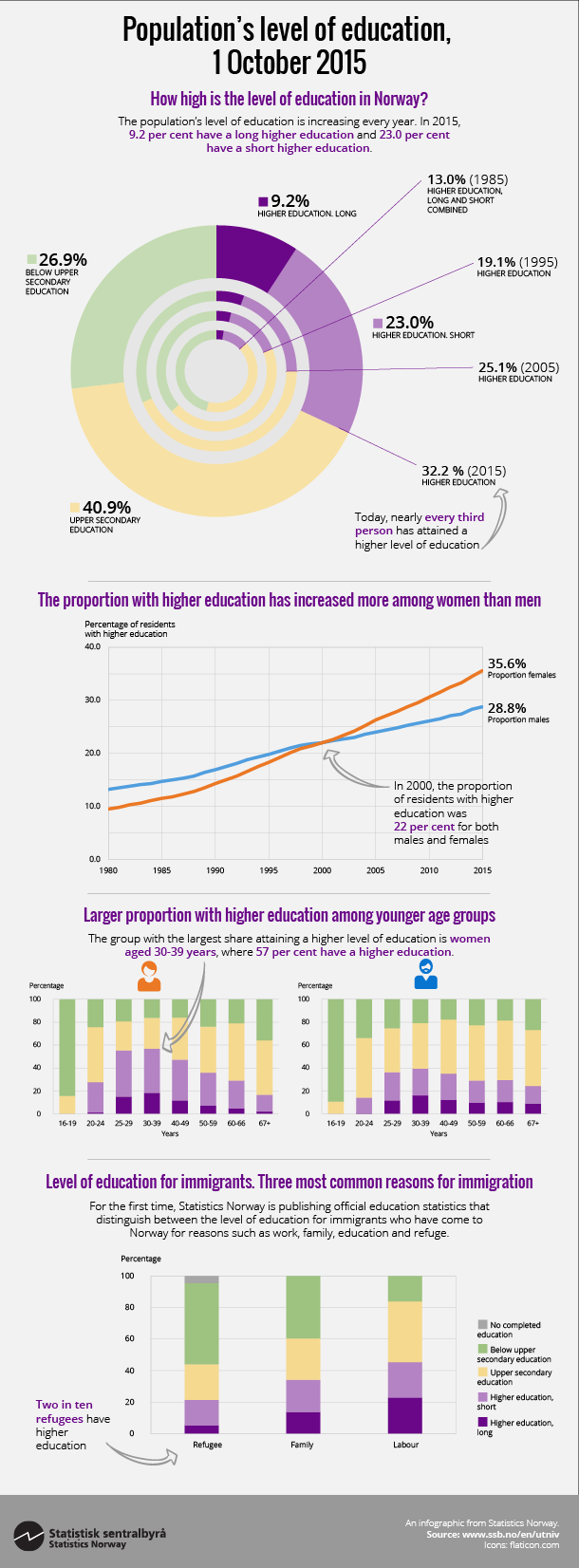Content
Published:
This is an archived release.
Two in ten refugees have higher education
For the first time, Statistics Norway is publishing official education statistics that distinguish between the level of education for immigrants who have come to Norway for reasons such as work, family, education and refuge.
| 2010 | 2015 | |||
|---|---|---|---|---|
| Males | Females | Males | Females | |
| 1For many immigrants SSB has no information about their level of education. 2014 figures includes an estimated level of education for missing values for these immigrants. See About the statistics for more information. | ||||
| 2Includes intermediate level courses based on completed upper secondary level, but which are not accredited as tertiary education | ||||
| 3Higher education, short comprises higher education up to 4 years in duration. | ||||
| 4Higher education, long comprises higher education more than 4 years in duration. | ||||
| 5People with unknown or no completed education are not included. | ||||
| Total | 1 956 835 | 1 981 012 | 2 117 010 | 2 104 975 |
| Below upper secondary education | 541 295 | 570 084 | 570 495 | 557 697 |
| Upper secondary education2 | 857 139 | 768 501 | 927 460 | 787 750 |
| Higher education, short3 | 332 068 | 479 292 | 394 123 | 570 821 |
| Higher education, long4 | 160 181 | 109 446 | 211 317 | 173 438 |
| Of this: | ||||
| Ph.D. | 15 161 | 7 815 | 24 909 | 17 117 |
| Unknown or no completed education1 | 66 152 | 53 689 | 13 615 | 15 269 |
| Per cent5 | ||||
| Below upper secondary education | 28.6 | 29.6 | 27.1 | 26.7 |
| Upper secondary education2 | 45.3 | 39.9 | 44.1 | 37.7 |
| Higher education, short3 | 17.6 | 24.9 | 18.7 | 27.3 |
| Higher education, long4 | 8.5 | 5.7 | 10.0 | 8.3 |
| Of this | ||||
| Ph.D. | 0.8 | 0.4 | 1.2 | 0.8 |
The level of education through 46 years
In Norway, 32 per cent of the population has a higher education. This proportion has increased by 0.8 percentage points since last year, and by 25 percentage points since 1970 when Statistics Norway began recording education statistics. As of today, there are still more people with an upper secondary education (41 per cent) than a higher education in Norway. This has been the situation since 1989 when the proportion with an upper secondary education (42.6 per cent) passed the proportion with a primary or lower secondary education (42.5).
There are no large fluctuations in the level of education from year to year and the Norwegian statistics for 2015 show the same trend we have seen in recent years. For example, we see that:
- Growing numbers have a higher education and the number with a primary education as their highest education is decreasing.
- More women than men have a higher education, and particularly a large proportion of women between 25 and 39 years have completed studies at tertiary level.
- The level of education is highest in the counties where the large universities are located, and about every other person in Oslo has a higher education.
However, for the first time, Statistics Norway is publishing the population's education by reason for immigration. The statistics now distinguish between educational attainments by background for immigration. The groups are divided into family, labour, education and refuge. The figure above shows that there are significant differences in the level of education between labour immigrants, family immigrants and refugees.
For more detailed information about immigrants’ levels of education see the table “Level of education for immigrants 16 years and older. Sex, country background and reason for immigration. Numbers and per cent”.
Contact
-
Andrine Stengrundet
E-mail: andrine.stengrundet@ssb.no
tel.: (+47) 95 48 60 28
-
Anne Marie Rustad Holseter
E-mail: anne.marie.rustad.holseter@ssb.no
tel.: (+47) 93 45 98 35
-
Maj-Lisa Lervåg
E-mail: maj-lisa.lervag@ssb.no
tel.: (+47) 45 68 84 72

